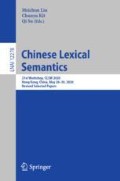Abstract
One criterion of linguistic theory is descriptive adequacy, i.e., whether it can capture the speaker’s intuition [1]. Traditional structuralist analyses and contemporary generative grammar largely confine themselves to structural description and analyses, which fails to explain the precise use of linguistic units. For example, one would find that for the Chinese compound word ròujiámó, 1) the speaker does not have to possess the structural knowledge to know how it is understood and used; and 2) people might have different perceptions towards words with supposedly identical structures, say, ròujiámó and dànchǎofàn. It is argued in this paper that Chinese compounds in general and ròujiámó in particular support two central claims of Cognitive Grammar, i.e., 1) linguistic units are stored in our brain in the form of networks of constructions; 2) the sanction of linguistic expressions is not the simple computation of rules but motivated by the whole network of constructions.
Access this chapter
Tax calculation will be finalised at checkout
Purchases are for personal use only
Notes
- 1.
Note that the italicized form indicates the name of the snack, whereas the non-italicized form indicates the snack itself.
- 2.
Note that the subscript Ag. and Pt. are short for agent and patient respectively. Strictly speaking, mó and ròu are not agent and patient per se. However, if agent and patient are defined in a broader sense as two asymmetrical entities in in terms of force dynamics, mó and ròu can be taken as such. See [21] for the discussion of the distinction between proto-agent and proto-patient roles.
References
Chomsky, N.: Aspects of the Theory of Syntax. MIT Press, Cambridge (1965)
Marantz, A.: On the Nature of Grammatical Relations. The MIT Press, Cambridge (1984)
Baker, M.: Incorporation: A Theory of Grammatical Function Changing. Chicago University Press, Chicago (1988)
Gu, Y., Shen, Y.: The derivation of synthetic compounds in Chinese (汉语合成复合词的构造过程). Zhongguo Yuwen 2, 122–133 (2001)
Shi, D.: Chinese attributive V-N compounds (汉语的定中关系动-名复合词). Zhongguo Yuwen 6, 483–495 (2003)
Zhou, R.: A study on Chinese VON/OVN compounds under typological evidence: Universality vs. individuality (共性与个性下的汉语动宾饰名复合词研究). Zhongguo Yuwen (4), 301–312 (2006)
Pei, Y., Qiu, J., Wu, Y.: The structure of ‘zhizhang fensuiji’(“纸张粉碎机”的层次结构). Contemporary Linguistics 4, 356–364 (2010)
Cheng, G., Zhou, G.: Verb-object compounding in Chinese: A distributed morphology approach (分布式形态学框架下的汉语动宾复合词研究). Foreign Lang. Teach. Res. 2, 163–175 (2015)
Zhou, G.: A review of generative approaches to compounding (生成语法视角下复合词构词机制研究述评). J. PLA Univ. Foreign Lang. 3, 42–50 (2018)
Xu, L.: Generative Grammar: From the Standard Theory to the Minimalist Program (生成语法理论 : 标准理论到最简方案). Shanghai Education Press, Shanghai (2009)
Xu, Y.: A short discussion on ròujiámó (小议“肉夹馍”). Sinogram Culture 17, 105–107 (2019)
Langacker, R.: Foundations of Cognitive Grammar: Theoretical Prerequisites, vol. 1. Stanford University Press, Stanford (1987)
Langacker, R.: Foundations of Cognitive Grammar: Descriptive Applications, vol. 2. Stanford University Press, Stanford (1991)
Langacker, R.: Cognitive Grammar: A Basic Introduction. Oxford University Press, Oxford (2008)
Liu, J.: Ròujiámó: a special linguistic phenomenon (“肉夹馍”: 一种特殊的语言现象). J. Hum. 2, 119–121 (1997)
Li, J.: Verbs as Attributives in Modern Chinese (现代汉语动词直接做定语研究). Commercial Press, Beijing (2008)
Chen, Y.: The relator principle and the N1 VN2 (NP) construction (联系项居中原则与N1 VN2 (NP) 结构). Chinese Teach. World 2, 51–62 (2006)
Langacker, R.: Grammar and Conceptualization. Mouton de Gruyter, Berlin (1999)
Fauconnier, G., Turner, M.: The Way We Think: Conceptual Blending and the Mind’s Hidden Complexities. Basic Books, New York (2002)
Johnson, M.: The Body in the Mind: The Bodily Basis of Meaning, Imagination and Reason. Chicago University Press, Chicago (1987)
Dowty, D.: Thematic proto-roles and argument Selection. Language 67(3), 547–619 (1991)
Author information
Authors and Affiliations
Corresponding author
Editor information
Editors and Affiliations
Rights and permissions
Copyright information
© 2021 Springer Nature Switzerland AG
About this paper
Cite this paper
Wang, L., Xu, X., Zhang, R. (2021). On the Adequacy of Grammatical Description: The Case of Ròujiámó (肉夹馍). In: Liu, M., Kit, C., Su, Q. (eds) Chinese Lexical Semantics. CLSW 2020. Lecture Notes in Computer Science(), vol 12278. Springer, Cham. https://doi.org/10.1007/978-3-030-81197-6_28
Download citation
DOI: https://doi.org/10.1007/978-3-030-81197-6_28
Published:
Publisher Name: Springer, Cham
Print ISBN: 978-3-030-81196-9
Online ISBN: 978-3-030-81197-6
eBook Packages: Computer ScienceComputer Science (R0)

